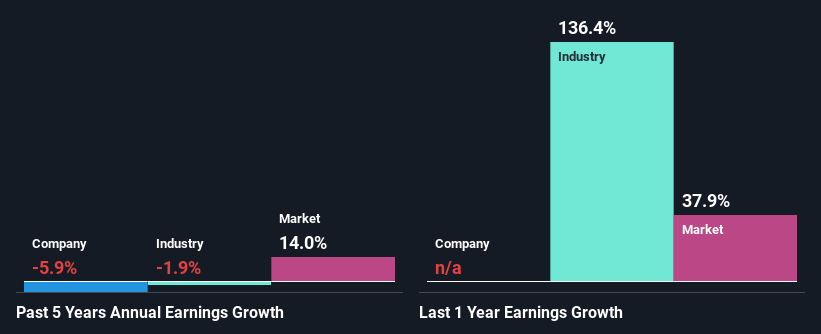Should Weakness in Darden Restaurants, Inc.'s (NYSE:DRI) Stock Be Seen As A Sign That Market Will Correct The Share Price Given Decent Financials?
With its stock down 17% over the past three months, it is easy to disregard Darden Restaurants (NYSE:DRI). However, stock prices are usually driven by a company’s financials over the long term, which in this case look pretty respectable. Specifically, we decided to study Darden Restaurants' ROE in this article.
Return on equity or ROE is a key measure used to assess how efficiently a company's management is utilizing the company's capital. In simpler terms, it measures the profitability of a company in relation to shareholder's equity.
Check out our latest analysis for Darden Restaurants
How Do You Calculate Return On Equity?
The formula for return on equity is:
Return on Equity = Net Profit (from continuing operations) ÷ Shareholders' Equity
So, based on the above formula, the ROE for Darden Restaurants is:
36% = US$923m ÷ US$2.5b (Based on the trailing twelve months to November 2021).
The 'return' is the amount earned after tax over the last twelve months. So, this means that for every $1 of its shareholder's investments, the company generates a profit of $0.36.
What Is The Relationship Between ROE And Earnings Growth?
Thus far, we have learned that ROE measures how efficiently a company is generating its profits. Depending on how much of these profits the company reinvests or "retains", and how effectively it does so, we are then able to assess a company’s earnings growth potential. Assuming all else is equal, companies that have both a higher return on equity and higher profit retention are usually the ones that have a higher growth rate when compared to companies that don't have the same features.
A Side By Side comparison of Darden Restaurants' Earnings Growth And 36% ROE
To begin with, Darden Restaurants has a pretty high ROE which is interesting. Second, a comparison with the average ROE reported by the industry of 16% also doesn't go unnoticed by us. As you might expect, the 5.9% net income decline reported by Darden Restaurants doesn't bode well with us. We reckon that there could be some other factors at play here that are preventing the company's growth. Such as, the company pays out a huge portion of its earnings as dividends, or is faced with competitive pressures.
As a next step, we compared Darden Restaurants' performance with the industry and found thatDarden Restaurants' performance is depressing even when compared with the industry, which has shrunk its earnings at a rate of 1.9% in the same period, which is a slower than the company.
Earnings growth is a huge factor in stock valuation. It’s important for an investor to know whether the market has priced in the company's expected earnings growth (or decline). This then helps them determine if the stock is placed for a bright or bleak future. What is DRI worth today? The intrinsic value infographic in our free research report helps visualize whether DRI is currently mispriced by the market.
Is Darden Restaurants Efficiently Re-investing Its Profits?
Looking at its three-year median payout ratio of 45% (or a retention ratio of 55%) which is pretty normal, Darden Restaurants' declining earnings is rather baffling as one would expect to see a fair bit of growth when a company is retaining a good portion of its profits. It looks like there might be some other reasons to explain the lack in that respect. For example, the business could be in decline.
In addition, Darden Restaurants has been paying dividends over a period of at least ten years suggesting that keeping up dividend payments is way more important to the management even if it comes at the cost of business growth. Our latest analyst data shows that the future payout ratio of the company is expected to rise to 57% over the next three years. Regardless, the future ROE for Darden Restaurants is speculated to rise to 66% despite the anticipated increase in the payout ratio. There could probably be other factors that could be driving the future growth in the ROE.
Conclusion
In total, it does look like Darden Restaurants has some positive aspects to its business. Yet, the low earnings growth is a bit concerning, especially given that the company has a high rate of return and is reinvesting ma huge portion of its profits. By the looks of it, there could be some other factors, not necessarily in control of the business, that's preventing growth. Having said that, looking at current analyst estimates, we found that the company's earnings growth rate is expected to see a huge improvement. Are these analysts expectations based on the broad expectations for the industry, or on the company's fundamentals? Click here to be taken to our analyst's forecasts page for the company.
Have feedback on this article? Concerned about the content? Get in touch with us directly. Alternatively, email editorial-team (at) simplywallst.com.
This article by Simply Wall St is general in nature. We provide commentary based on historical data and analyst forecasts only using an unbiased methodology and our articles are not intended to be financial advice. It does not constitute a recommendation to buy or sell any stock, and does not take account of your objectives, or your financial situation. We aim to bring you long-term focused analysis driven by fundamental data. Note that our analysis may not factor in the latest price-sensitive company announcements or qualitative material. Simply Wall St has no position in any stocks mentioned.

 Yahoo Finance
Yahoo Finance 
